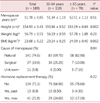Abstract
Objectives
Isoflavone is a plant-derived compound, abundant in soy food, and its character is mixed estrogenic and antiestrogenic action, so it is highlighted as an alternative to hormone replacement therapy (HRT) in postmenopausal women. The purpose of this study is to establish a foundation for isoflavone study in the future, by estimating isoflavone intake in postmenopausal women and by recommending proper isoflavone intake.
Methods
Isoflavone intake was estimated in a total of 189 Korean postmenopausal women over 50 years old, by using a food frequency questionnaire (FFQ). Data were statistically analyzed by t-test, and one-way ANOVA with Turkey's test.
Figures and Tables
References
1. Soules MR, Sherman S, Parrott E, Rebar R, Santoro N, Utian W, et al. Executive summary: Stages of Reproductive Aging Workshop (STRAW) Park City, Utah, July, 2001. Menopause. 2001. 8:402–407.
2. Polo-Kantola P, Erkkola R, Helenius H, Irjala K, Polo O. When does estrogen replacement therapy improve sleep quality? Am J Obstet Gynecol. 1998. 178:1002–1009.
3. Rossouw JE, Anderson GL, Prentice RL, LaCroix AZ, Kooperberg C, Stefanick ML, et al. Risks and benefits of estrogen plus progestin in healthy postmenopausal women: principal results From the Women's Health Initiative randomized controlled trial. JAMA. 2002. 288:321–333.
4. Manson JE, Hsia J, Johnson KC, Rossouw JE, Assaf AR, Lasser NL, et al. Estrogen plus progestin and the risk of coronary heart disease. N Engl J Med. 2003. 349:523–534.
5. Hersh AL, Stefanick ML, Stafford RS. National use of postmenopausal hormone therapy: annual trends and response to recent evidence. JAMA. 2004. 291:47–53.
6. Levis S, Strickman-Stein N, Doerge DR, Krischer J. Design and baseline characteristics of the soy phytoestrogens as replacement estrogen (SPARE) study--a clinical trial of the effects of soy isoflavones in menopausal women. Contemp Clin Trials. 2010. 31:293–302.
7. Ewies AA. Phytoestrogens in the management of the menopause: up-to-date. Obstet Gynecol Surv. 2002. 57:306–313.
8. Notelovitz M. Estrogen replacement therapy: indications, contraindications, and agent selection. Am J Obstet Gynecol. 1989. 161:1832–1841.
9. Albertazzi P, Pansini F, Bonaccorsi G, Zanotti L, Forini E, De Aloysio D. The effect of dietary soy supplementation on hot flushes. Obstet Gynecol. 1998. 91:6–11.
10. Nikander E, Kilkkinen A, Metsä-Heikkilä M, Adlercreutz H, Pietinen P, Tiitinen A, et al. A randomized placebo-controlled crossover trial with phytoestrogens in treatment of menopause in breast cancer patients. Obstet Gynecol. 2003. 101:1213–1220.
11. Kim J, Kwon C. Estimated dietary isoflavone intake of Korean population based on National Nutrition Survey. Nutr Res. 2001. 21:947–953.
12. Choi YB, Sohn HS. Isoflavone content in Korean fermented and unfermented soybean foods. Korean J Food Sci Technol. 1998. 30:745–750.
13. Won HJ, Lee BS, Lee SK, Choi Y, Yoon S, Park KH, et al. The effect of isoflavone on postmenopausal symptoms and hormonal changes in postmenopausal women. J Korean Soc Menopause. 2001. 7:54–63.
14. Lee BS, Won HJ, Lee SK, Cho Y, Yoon S, Park KH, et al. The effect of isoflavone on serum lipid profiles and bone markers in postmenopausal women. J Korean Menopause Soc. 2002. 8:59–67.
15. Kim WW, Lee KS, Lee SH. An immunohistochemical study on alkaline phosphatase activity in osteoblasts cultured with isoflavone. J Korean Menopause Soc. 2002. 8:19–26.
16. Scambia G, Mango D, Signorile PG, Anselmi Angeli RA, Palena C, Gallo D, et al. Clinical effects of a standardized soy extract in postmenopausal women: a pilot study. Menopause. 2000. 7:105–111.
17. Messina M, McCaskill-Stevens W, Lampe JW. Addressing the soy and breast cancer relationship: review, commentary, and workshop proceedings. J Natl Cancer Inst. 2006. 98:1275–1284.
18. Messina M, Nagata C, Wu AH. Estimated Asian adult soy protein and isoflavone intakes. Nutr Cancer. 2006. 55:1–12.
19. Boker LK, Van der Schouw YTr, De Kleijn MJ, Jacques PF, Grobbee DE, Peeters PH. Intake of dietary phytoestrogens by Dutch women. J Nutr. 2002. 132:1319–1328.
20. Horn-Ross PL, John EM, Lee M, Stewart SL, Koo J, Sakoda LC, et al. Phytoestrogen consumption and breast cancer risk in a multiethnic population: the Bay Area Breast Cancer Study. Am J Epidemiol. 2001. 154:434–441.
21. Husband A. Red clover isoflavone supplements: safety and pharmacokinetics. J Br Menopause Soc. 2001. 7:Suppl 1. 4–7.
22. Sung CJ, Choi SH, Kim MH, Park MH, Ko BS, Kim HK. A study on dietary isoflavone intake from soy food and urinary isoflavone excretion and, menopausal symptoms in Korean women in rural areas. Korean J Community Nutr. 2000. 5:120–129.
23. Lee SK, Lee MJ, Kwon DJ. Estimated isoflavone intake from soy products in Korean middle-aged women. J Korean Soc Food Sci Nutr. 2000. 29:948–956.
24. Choi MK, Kim MH, Sung CJ, Lee WY, Park JD. A study on relation among habitual isoflavone intake, blood pressure, and serum lipid parameters in Korean men and women over 20 years old. Korean J Community Nutr. 2005. 10:493–500.
25. Lee MJ, Kim JH. Estimated dietary isoflavone intake among Korean adults. Nutr Res Pract. 2007. 1:206–211.
26. Setchell KDR. Absorption and metabolism of isoflavones. Soy Connect Newsl. 2008. 6:1–3.
27. Palacios S, Pornel B, Bergeron C, Chantre P, Nogales F, Aubert L, et al. Endometrial safety assessment of a specific and standardized soy extract according to international guidelines. Menopause. 2007. 14:1006–1011.
28. Penotti M, Fabio E, Modena AB, Rinaldi M, Omodei U, Viganó P. Effect of soy-derived isoflavones on hot flushes, endometrial thickness, and the pulsatility index of the uterine and cerebral arteries. Fertil Steril. 2003. 79:1112–1117.
29. Unfer V, Casini ML, Costabile L, Mignosa M, Gerli S, Di Renzo GC. Endometrial effects of long-term treatment with phytoestrogens: a randomized, double-blind, placebo-controlled study. Fertil Steril. 2004. 82:145–148. quiz 265.




 PDF
PDF ePub
ePub Citation
Citation Print
Print





 XML Download
XML Download